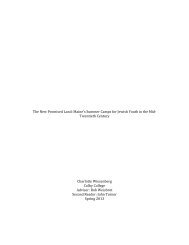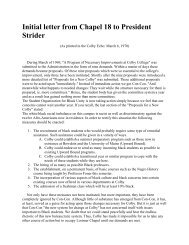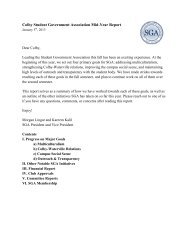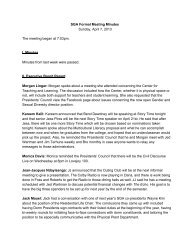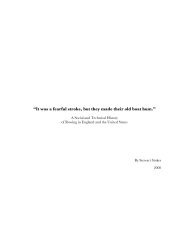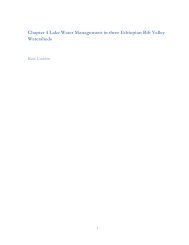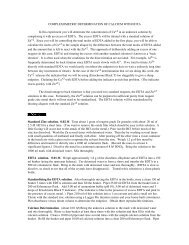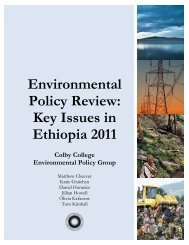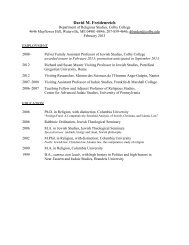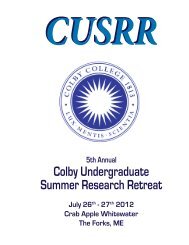Salmon Lake and McGrath Pond Watershed 2009
Salmon Lake and McGrath Pond Watershed 2009
Salmon Lake and McGrath Pond Watershed 2009
Create successful ePaper yourself
Turn your PDF publications into a flip-book with our unique Google optimized e-Paper software.
The recent discovery of Eurasian watermilfoil in Kozy Cove of <strong>Salmon</strong> <strong>Lake</strong> is<br />
particularly troubling for Great <strong>Pond</strong> because water flows from <strong>Salmon</strong> <strong>Lake</strong> to Great<br />
<strong>Pond</strong> by way Kozy Cove <strong>and</strong> Hatchery Brook. Once discovered, the Maine Department<br />
of Environmental Protection took actions to eradicate the presence of Eurasian<br />
watermilfoil in Kozy Cove, on the southeast side of <strong>Salmon</strong> <strong>Lake</strong>. Because the majority<br />
of <strong>Salmon</strong> <strong>Lake</strong> <strong>and</strong> <strong>McGrath</strong> <strong>Pond</strong> is shallow (less than 8 m) <strong>and</strong> invasive macrophytes<br />
such as Eurasian watermilfoil prefer shallow water for colonization <strong>and</strong> establishment,<br />
these lakes are at high risk of invasive species colonization. Continued monitoring <strong>and</strong><br />
vigilance of volunteers, researchers <strong>and</strong> residents is critical for the prevention of further<br />
invasive species establishment.<br />
The mean epicore phosphorus concentration in <strong>Salmon</strong> <strong>Lake</strong> <strong>and</strong> <strong>McGrath</strong> <strong>Pond</strong> was 13.0<br />
ppb <strong>and</strong> 10.6 ppb respectively. The largest external contributors to phosphorus loading<br />
as percentages of the total external load into the water body are shoreline residential<br />
septic systems (14.9%), atmospheric input (13.1%), cropl<strong>and</strong> (11.1%), shoreline<br />
development (10.1%), non-shoreline development (9.1%), logged areas (8.7%) <strong>and</strong> youth<br />
camp septic systems (8.6%).<br />
<strong>Salmon</strong> <strong>Lake</strong> <strong>and</strong> <strong>McGrath</strong> <strong>Pond</strong> have a flushing rate of 0.47 flushes per year, based on<br />
the water budget calculated by CEAT, with 66% of water inputs coming from runoff <strong>and</strong><br />
34% from precipitation.<br />
L<strong>and</strong> use has undergone several changes in the period between 1965/66 <strong>and</strong> 2007:<br />
o Non-shoreline residential area has increased 142.9% <strong>and</strong> now covers 135 ha of<br />
the watershed. Shoreline residences have increased by only 29.5% (54.9 ha),<br />
likely because much of the shoreline was already developed by 1965/66.<br />
o CEAT estimates that there are 19 shoreline lots that could be developed. There<br />
are also other non-shoreline areas where potential development might occur<br />
within the watershed. Limits to development include lack of municipal sewage<br />
<strong>and</strong> water treatment, the topography of the watershed, shoreline zoning<br />
ordinances <strong>and</strong> the current economic downturn.<br />
o Agricultural l<strong>and</strong> decreased 60.1% since 1965/66, which is consistent with trends<br />
in surrounding watersheds <strong>and</strong> throughout central Maine.<br />
o Logged area in the northwestern part of the watershed has increased significantly,<br />
from 3.3% to 8.2%.<br />
o Forested l<strong>and</strong> in the watershed has significantly decreased from 71.5% to 65.1%<br />
(a decrease of 71 ha) due to logging <strong>and</strong> development.<br />
o High impact development, which includes commercial <strong>and</strong> municipal l<strong>and</strong> uses,<br />
increased from 2.23 ha in 1965/66 to 14.2 ha (0.69%) in 2007.<br />
There are 66 camp roads, 3 state roads <strong>and</strong> 12 town roads in the <strong>Salmon</strong>/<strong>McGrath</strong><br />
watershed. Camp roads cover 13.2 miles, <strong>and</strong> state <strong>and</strong> town roads cover 27.7 miles.<br />
Many of the camp roads could have a negative impact on the watershed due to their<br />
proximity to the shoreline. Camp roads are generally privately owned <strong>and</strong> maintained by<br />
residents living on each road. Many camp roads fall into disrepair because residents lack<br />
the funding <strong>and</strong> knowledge of road repair to keep the road well maintained.<br />
Based on the CEAT road survey, over half of the camp roads are in fair (35%) or poor<br />
(23%) condition, <strong>and</strong> are likely contributors of phosphorus into the lake. These roads<br />
will continue to pose problems, if they are not repaired <strong>and</strong> maintained. Likewise, further<br />
degradation of roads currently rated as good (15%) or acceptable (27%) could increase<br />
2



